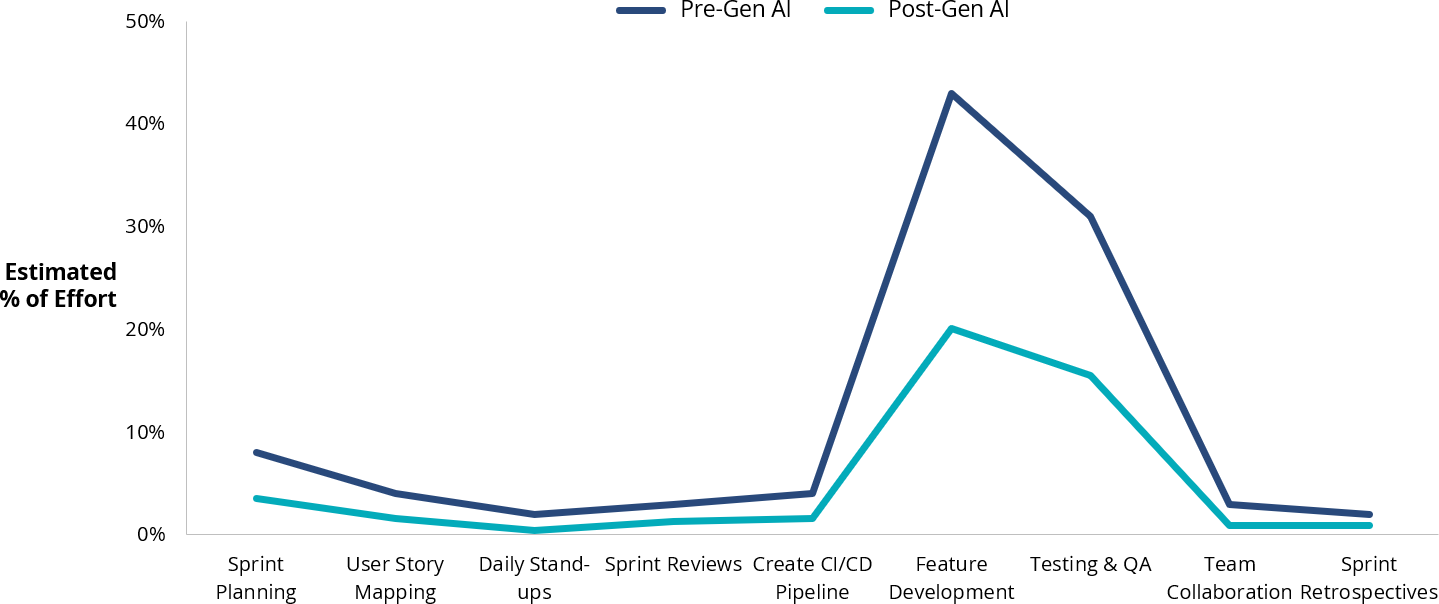The integration of generative AI (GenAI) into software development is a transformative leap forward. It enables organizations to accelerate product development and ensure that the resulting software meets market needs and high-quality standards.
How?
Software developers can use GenAI to prioritize features and functions that align with market demands, expedite development through agile methodologies and enhance overall software quality.
Prioritizing Features and Functions to Meet Market Needs
GenAI can analyze vast amounts of market data, user feedback and competitive landscapes to identify and prioritize features that will resonate with users. This capability ensures that development efforts are focused on high-impact areas, thereby increasing the likelihood of market success.
- Data-driven decision-making: GenAI uses machine learning algorithms to process and analyze market trends, customer feedback and usage data. This analysis helps identify key features that are in high demand and have the potential to deliver significant value to users.
- User behavior analysis: By analyzing user interactions and feedback, GenAI can predict which features will enhance user satisfaction and engagement. This allows product teams to prioritize development efforts on features that will improve the user experience and drive adoption.
- Competitive analysis: GenAI can continuously monitor competitor offerings and market shifts, providing insights into gaps and opportunities. This enables development teams to stay ahead of the curve by introducing innovative features that differentiate their products from competitors.
Accelerating Development Through Agile Methodologies
Agile development processes benefit significantly from the integration of GenAI, which can automate and optimize various stages of the software development lifecycle.
- Sprint planning and backlog prioritization: GenAI aids in sprint planning by analyzing historical data and current project requirements to prioritize tasks that deliver the most value. This ensures development efforts are aligned with strategic goals and market needs.
- Automated task estimation: GenAI models provide accurate task estimations based on past project data, reducing the time spent on planning and improving the accuracy of project timelines.
- Daily stand-ups and progress tracking: AI-driven tools can automatically update task status, predict potential delays and provide real-time insights into project progress. This helps teams stay on track and address issues proactively.
- Continuous integration and deployment (CI/CD): GenAI predicts integration failures and suggests remedies, streamlining the CI/CD process and reducing the risk of deployment errors. Automated testing and validation further ensure that code changes do not introduce new issues.
Estimated Productivity Improvements with GenAI across Agile Development Process

Source: ISG Research May 2024
Enhancing Software Quality
GenAI significantly enhances software quality by improving testing processes, enforcing coding standards and providing continuous monitoring and optimization.
- Automated testing: GenAI automates the generation and execution of test cases, ensuring comprehensive coverage and faster identification of defects. This reduces the manual effort required for testing and increases the reliability of the software.
- Code reviews and static analysis: AI-driven code review tools analyze code for potential issues and adherence to best practices. This ensures that code quality is maintained throughout the development process and reduces the likelihood of defects.
- Dynamic testing and security assessments: GenAI-driven tools perform dynamic testing and security assessments, identifying vulnerabilities and performance issues that might not be evident through static analysis alone. This enhances the overall security and performance of the software.
- Continuous monitoring and optimization: Post-deployment, GenAI continuously monitors the software for performance and security issues, providing real-time insights and automated remediation. This ensures the software remains robust and secure throughout its lifecycle.
Defect Injection Rates Significantly Reduced with GenAI Code and Testing Tools

Source: ISG Research, software development project with 11 FTEs working for 5 1/2 months. Overall cost of $1M
The integration of GenAI into software development processes offers a compelling advantage for organizations looking to accelerate product development, align features with market needs and enhance software quality. By leveraging GenAI's capabilities in data analysis, task automation and continuous optimization, development teams can achieve unprecedented levels of efficiency and effectiveness. Of course, the technology will continue to evolve and its impact on software development will increase, driving further innovation and competitive advantage in the market.
Explore The Impact of Generative AI on Software Testing here.
